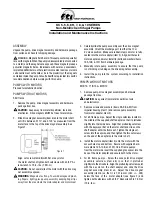
Page 57
EA Elektro-Automatik GmbH
Helmholtzstr. 31-33 • 41747 Viersen
Germany
Fon: +49 2162 / 3785-0
Fax: +49 2162 / 16230
PSI 9000 2U Series
3.4.4.5 Application examples
a) Switching off output with pin “Rem-SB”
The pin Rem-SB can be used in remote control to switch the output on and off. It is recom-
mended that a low resistance contact such as a switch, relay or transistor is used to switch
the pin to ground (DGND).
A digital output, e.g. from a PLC, may be unable to cleanly effect this as
it may not be of low enough resistance. Check the specification of the
controlling application. See also 3.4.4.4 above.
b) Reading actual values
Via the AI the output values for current and voltage can be monitored. These can be
read using a standard multimeter or similar.
c) Remote control of current and power
Requires remote control to be activated (Pin “Remote” = LOW)
The set values PSEL CSEL are generated from, for example, the
reference voltage VREF using potentiometers for each. Hence the
power supply can selectively work in current limiting or power limit-
ing mode. According to the specification of max. 5 mA for the VREF
output, potentiometers of at least 10 kΩ must be used.
The voltage set value VSEL is permanently assigned to VREF and
will thus be permanently 100%.
If the control voltage is fed in from an external source it is necessary to
consider the input voltage ranges for set values (0...5 V oder 0...10 V).
Use of the input voltage range 0...5 V for 0...100%
set value halves the effective resolution.
Example with external
voltage source
Example with
potentiometers
3.4.4.6 Acknowledging device alarms
Device alarms (see
) are always indicated in the front display and some of them are also reported as signal on
the analog interface socket (see
), for example the overvoltage alarm (OV), which is considered as critical.
In case of a device alarm occurring during remote control via analog interface, the DC output will be switched off
the same way as in manual control. While alarms OT and OV can be monitored via the corresponding pins of the
interface, other alarms like power fail (PF) can’t. Those could only be monitored and detected via the actual values
of voltage and current being all zero contrary to the set values.
All device alarms (OT, OV, PF, OCP and OPP) have to be acknowledged, either by the user of the device or by the
controlling unit. Also see
„3.5.2. Device alarm and event handling“
.
Acknowledgement is done with pin REM-SB
switching the DC output off and on again, means a HIGH-LOW-HIGH edge (min. 50ms for LOW).
















































